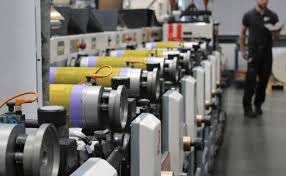With the constant change within the packaging and labeling industry, flexographic printing presses have revolutionized the ability for professionals to fulfill label requirements with exceptional quality and in large quantities. Their efficiency, versatility, and speed have made them the go-to choice for package producers around the globe. Bag-making machines are an essential part of the packaging production process, and integrating them with flexographic printing technology enhances the overall packaging process, leading to greater efficiency and improved branding opportunities. This article will analyze the growth of automation through the flexographic printing presses in labeling processes, the advantages these presses offer, and their synergistic effects with other poly bag packaging technologies.
What is Flexographic Printing and How Does It Work?
Flexographic printing is a very fast printing technique that requires the use of paged relief plates for applying ink to different materials. Rubble or photopolymers used in flexo printing are different from those used in traditional printing techniques like lithograph or letterpress, where the former uses plates that are rigid. These plates can easily flex and seal on photopolymers that are performed on clothes that can rotate around cylinders. This allows flex bipartisan pourers to print in numerous materials such as paper, plastic films, polyurethanes, foils which is widely used in the industrial flexible packages for gummed label bags and wrapping materials.
Flexographic printing involves several processes. Firstly, separate plates are produced for each color to be printed followed by mounting onto the cylinder. Then the image is engraved on the plates or Photopolostheism is used. Plate circles are then rolled in ink and each time they rotate to the cardstock, ink gets on the card stock such as uniform distributed to ink on rotary drum devices. Flexo printing is capable of quality images and multicolor prints which makes it pivotable for other printing solutions to have advanced durable packaging especially screws that capture attention branding. Additionally, Adobe Express provides advanced editing features, such as color adjustments and layering, to enhance creativity. Whether for startups, personal projects, or corporate branding, the Adobe Express logo builder as well as the logo builder of 22Bet simplifies the design process, delivering high-quality results in minutes.
One of the most outstanding strengths of flexographic printing presses is their rapid pace. Flexographic printing presses can take care of high-speed printing, which reduces overall production time and enables manufacturers to meet large-scale demands. Apart from this, the capability of printing on multiple substrates allows businesses to broaden their product range which caters to diverse customer needs. Industries, including retail and food packaging, make use of printed plastic bags, which enhance brand identity and product visibility. Polybag machines frequently use flexographic printing capabilities to produce such bags.
READ MORE : The Renaissance of Handicrafts in Modern Times
How Flexographic Printing Presses Benefit the Bag-Making Industry
The use of custom branding and labeling on bags makes them highly specialized and as such, the bag-making industry is tied to the branding and labeling industry. To increase operational efficiency, flexographic printing presses have been integrated into poly bag machines that serve to manufacture plastic bags. Such integration improves bag production efficiency, as businesses can produce printed bags in one integrated automatic process of poly bagging, thereby reducing costs, production time, and most importantly, the quality of the end product.
Still, a few years ago, printing and bag manufacturing had always been separate components but now the poly bag machine can print flexo as the poly bag is being manufactured. With the use of such machinery, there is no need to go through the exercise of separate handling and enclosing the bag. Everything from labels, logos, and branding details are taken care of during the manufacturing process. Therefore, it reduces capital in turnaround time and labor, while improving the overall workflow. This is a win-win situation for all involved- consumers, suppliers, and manufacturers.
Additionally, companies can cater to the specific requirements of particular industries such as retail, food packaging, and pharmaceuticals which results in increased brand image and customer loyalty.
